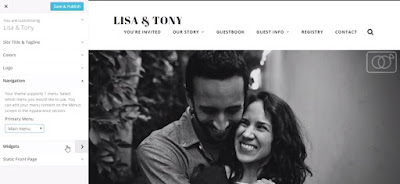To get to the customizer, you can go to the front end of your site. It doesn't really matter which page you're on. And I navigate to the WordPress toolbar and select Customize. This opens the theme customizer, and what you're looking at now, here on the right-hand side, is no longer the live website, but rather a custom version of the live website where you can experiment with different customization options until you get everything exactly right, and only then publish the new version of the site. In the customizer, for this particular theme, we have some limited options. At the top, we can change the Colors, and here we can only change the Accent Color.
The Accent Color is the hover color for different links. You can see it's currently blue. You see it in the site title, in regular links as a background, and you also see it when you hover over dropdowns. So if you want to change this to a different color, you can simply click Select Color and then use this color picker to find any color you think would work best for your theme. Or you can set it back to Default if you want to have this red color that is the default for the theme. Next, you have a Logo option, which allows you to upload a logo to replace the site title.
 Now, in my case, I'm not gonna use the logo because in my site, that wouldn't really work. But if you have a logo for your wedding or special event, you can choose to upload it here and see what it would look like in the header. Just keep in mind, you have to customize the logo to fit with the display that the theme designer specified when he created this particular theme. What I want to do here is change the navigation. And this can be done under the Navigation tab. From here, I can assign a specific custom menu to any of the available menu areas in my theme.
Now, in my case, I'm not gonna use the logo because in my site, that wouldn't really work. But if you have a logo for your wedding or special event, you can choose to upload it here and see what it would look like in the header. Just keep in mind, you have to customize the logo to fit with the display that the theme designer specified when he created this particular theme. What I want to do here is change the navigation. And this can be done under the Navigation tab. From here, I can assign a specific custom menu to any of the available menu areas in my theme.And in this theme, I only have one area, called Primary Menu. So I'm gonna use this dropdown to select the custom menu I created, Main menu. And when I do, you see my menu changes to that custom menu I created. Looking further down on my list, I also have a set of widgets for this theme. But as you can see from the layout, there are no sidebars in this theme. Instead, the theme designer has created three widgetized areas that would appear at the bottom of each page. I can show you what they look like by going into each of these widgetized areas and adding a widget.
So, maybe I'll add the Pages widget here on the first one. You see the Pages appear. Then I can add the Calendar in the next widgetized area. And finally, add Meta in the third area. Now, this is entirely optional. You can add as many widgets as you want or no widgets or you can use some custom widgets, like Image widget or Text widget, to add specific information in the footer. These widgetized areas will appear on all pages, so here you have to make a choice whether you want to add extra information on the bottom of each page.
It's also important to remember that this footer information will appear all the way at the bottom of the site if you're on a mobile device. So if you have something important to say, it might not be the best place to put it. You might want, instead, to create a new page for that important message. Once you're happy with the options you've set in the customizer, click Save & Publish, and now all those settings will become live on the front end of your site, and this is what your guests will see.


Không có nhận xét nào:
Đăng nhận xét